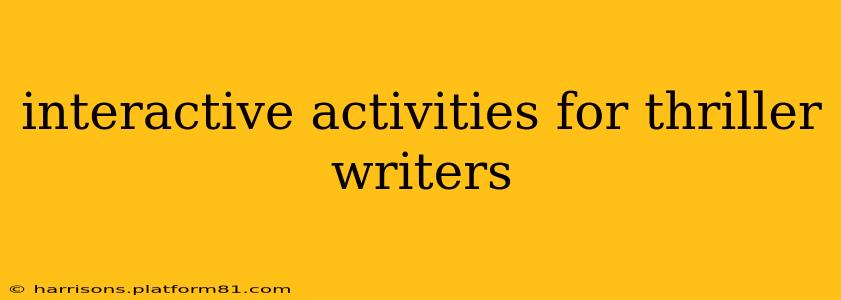Thriller writing demands more than just a gripping plot; it requires a deep understanding of suspense, character development, and pacing. Interactive activities can be incredibly valuable tools for honing these crucial skills and pushing your creative boundaries. These activities move beyond simple brainstorming and delve into experiential learning, helping you immerse yourself in the world of your thriller.
What are some interactive writing exercises for thrillers?
Interactive exercises for thriller writers go beyond passive brainstorming. They actively engage your senses and challenge you to think outside the box, pushing your creative boundaries and deepening your understanding of the thriller genre. Here are a few ideas:
1. The Sensory Immersion Exercise:
This exercise focuses on crafting vivid descriptions by engaging all five senses. Choose a crucial scene from your thriller—a tense confrontation, a chilling discovery, or a desperate escape. Now, describe the scene not just visually, but also through sound, smell, taste, and touch. For example, instead of simply writing "He entered the dark room," try: "He slipped into the suffocating darkness, the musty smell of damp earth and decay clinging to the air like a shroud. The only sound was the drip, drip, drip of water echoing in the oppressive silence, each drop a tiny hammer blow against his already frayed nerves. The rough texture of the cold stone wall scraped against his cheek as he felt his way forward, tasting the metallic tang of fear on his tongue."
2. The Character Swap Challenge:
This exercise forces you to examine your characters from multiple perspectives. Select two key characters from your thriller—perhaps an antagonist and protagonist—and write a short scene from each character's point of view, focusing on the same event. This reveals hidden motivations, conflicting interpretations of events, and allows you to deepen your understanding of each character's psychology.
3. The Unexpected Twist Workshop:
Thriller writing thrives on unexpected twists. Take a seemingly straightforward scene from your novel and brainstorm at least five different ways to introduce an unexpected twist. These twists could involve a new character, a hidden motive, a shocking revelation, or a sudden shift in power dynamics. This activity helps you develop the ability to subvert expectations and keep your readers guessing.
4. The Collaborative Plot Development Game:
Collaborate with other writers or a writing group to build a thriller plot. Each participant contributes a key element—a character, a setting, a crucial object, a plot point—and the group works together to weave these elements into a cohesive and suspenseful narrative. This interactive exercise encourages creativity, collaboration, and the exploration of different writing styles.
5. The "What If?" Scenario Generator:
Take a pivotal scene in your thriller and repeatedly ask "What if...?" questions. For example: "What if the protagonist didn't find the evidence?" "What if a secondary character betrayed the protagonist?" "What if the setting was dramatically different?" Exploring these "what if?" scenarios can lead to unexpected plot developments, compelling subplots, and deeper character arcs.
How can interactive activities improve my thriller writing?
These interactive activities serve multiple purposes:
- Boosting Creativity: They push you beyond your usual writing patterns, encouraging innovation and originality.
- Deepening Character Development: By exploring characters from different perspectives, you gain a richer understanding of their motivations, flaws, and strengths.
- Strengthening Plot Structure: The exercises help you identify plot holes, develop compelling twists, and create a more engaging narrative arc.
- Enhancing Pacing and Suspense: Focusing on sensory details and unexpected turns allows you to control the pacing and create a more thrilling reading experience.
- Improving Collaboration Skills (if done in a group): Working with other writers can offer valuable feedback and fresh perspectives.
By incorporating these interactive activities into your writing process, you’ll not only enhance your storytelling skills but also make the writing process itself more engaging and rewarding. Remember, the key is to actively participate, experiment, and embrace the unexpected twists and turns that these exercises can bring.
